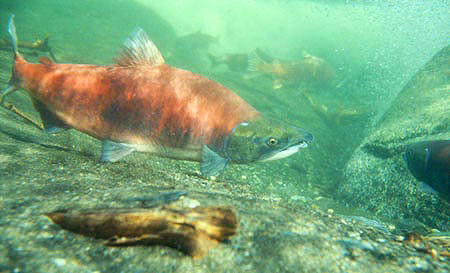Salmon set netters on the east side of Cook Inlet sat on the beach while the drift fleet and tens of thousands of dip netters and anglers lined the river, shoulder-to-shoulder to fish the peak of the sockeye runs in the Kenai and Kasilof Rivers.
“Every single user group is fishing at maximum capacity now,” says Ken Coleman, vice president of the Kenai Peninsula Fishermen’s Association, in Soldotna. As of July 24, Coleman and dozens of other shore-based family operations had fished only three days, and other operations in the harvest district north of him fished only two.
“It’s frustrating, maddening –pick an adjective,” says Coleman.
The Cook Inlet sockeye run begins in June and typically peaks between July 17 and the end of the month. Set netters fishing south of the Kasilof River had fished six openings, but for Coleman and his neighbors whose sites are near the Kenai River, restrictions to protect dwindling chinook returns have plagued fishing opportunity since 2012.
A July 20 fishing announcement by the Alaska Department of Fish and Game opened the offshore area of Cook Inlet, but stated that no set net openings would be in the offing unless the number of chinooks going by the in-river sonar counter improved.
Coleman blames politics for the closures and says that the biology would support set net openings for the beleaguered group.
Set netters along the entire east side of Cook Inlet had caught 32 chinooks in the 2022 season. Meanwhile, escapement of fish into the Kasilof River stood at 568,703 sockeyes and was projected to hit 926,000, almost triple of the 140,000 to 320,000 that is optimum for the river system to support for spawning. July 21 saw an all-time record sonar passage of 67,243 sockeys in a single day.
In the Kenai River escapement had reached 519,000 sockeyes as of July 20, with a total projected escapement of 1.7 million to 2.4 million. A subsequent ADF&G press release estimated escapement would hit 2.3 million.
The sonar that counts sockeye salmon is located 19 miles upriver. Drift netters and set netters have long contested the placement of the sonar as a tactic to ensure that a plethora of sockeyes have made it past their nets and into the lower river to appease dip netting and angling interests.
“It’s unfortunate that it’s politics over biology,” says Coleman, who has fished the same beach for 53 years. He believes that all of the protective measures for chinooks are a façade masking real motives to get more sockeyes into the rivers for other user groups.
“They’re all designed to keep set netters on the beach,” he says.
On July 21, ADF&G opened dip netting 24 hours a day, effective July 22 through July 31. That same day the bag limit for anglers upriver was increased from three sockeyes to six for the remainder of July. As of July 22, the total commercial harvest for the entire Cook Inlet fleet stood at 946,951 sockeyes.







